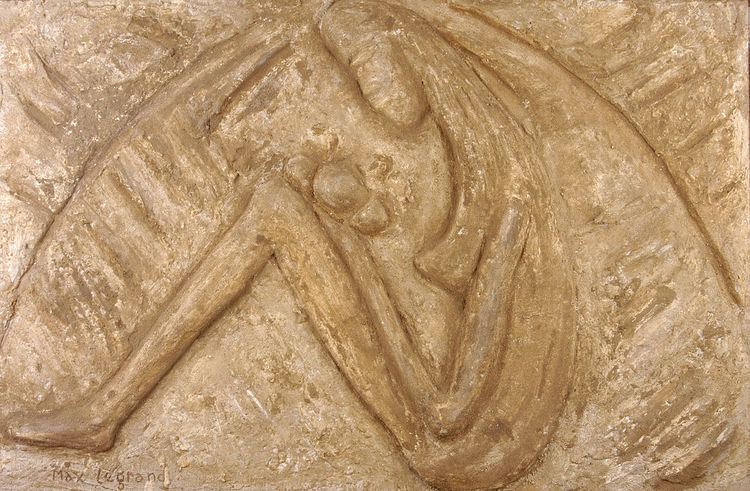Nationality French | Name Max Legrand | |
 | ||
Born February 26, 1958 Fort-de-France, Martinique | ||
Max Legrand Artist Painter Hamburg
Max Legrand (born February 26, 1958) is a French artist. His fields are painting, installations, poetry and Neo-expressionism. He has been influenced by Aime Cesaire, Marc Chagall, Cy Twombly, A.R. Penck, Henri Matisse, Miles Davis, and Charlie Parker. His career began in the late 1980s, when he started to produce Neo-expressionist paintings in Hamburg. His greatest inspiration for writing and painting originates from jazz music.
Contents
- Max Legrand Artist Painter Hamburg
- Early life
- Career
- Biography
- Artistic activities
- Art analysis
- References
Early life
Legrand was born in Fort-de-France, the capital of France's Caribbean overseas department of Martinique. He was the second of four children of Marie Alice Angarny and Paul Emmanuel Legrand. His father, Paul Emmanuel, was born in Fort-de-France, Martinique, and his mother, Marie Alice, was born in Fonds-Saint-Denis. Legrand was a very apt student in drawing and painting. His teachers noticed his artistic abilities, and his mother encouraged his artistic talent and creativity.
After the death of his mother in 1963, Legrand, his sister, and his brothers were raised by their grandmother. The family resided in Schoelcher Plateau Fofo for seven years, then moved to Boulevard de la Marne in 1970. Legrand attended the Lycee Polyvalent Technique et Professionnel of Fort de France until he was twenty years old. He was later obliged to join the French army in the South of France between 1978 and 1979.
Career
In 1979, Legrand began drawing and working on fashion shows in Paris. He collaborated with several young French artists and fashion designers. In 1986, Legrand was a member of the Amadeo Musical Dance Company in Paris. That same year, he worked with other groups and artists with whom he was later professionally involved. He also appeared in several live shows with the well known singer Jeane Manson. In June 1987, Legrand attended seminars at the Hochschule fur bildende Kunste Hamburg. In 1988, he was accepted at the Academy for advertising, graphics and print. He completed his training as a graphic designer assistant in Hamburg. In 1989, he made his first abstract portrait with mixed media.
Biography
Artistic activities
1999 La guitare Rock
Continuing his activities as a fine art artist, Legrand often incorporated words into his paintings. Before his career as a painter began, he produced poetry and installations while becoming known for investigations into the complex spectrum of the human existence. This study was from love to death within a framework of political, societal and religious developments. It runs like a contextual thread throughout the entire work of Legrand.
Art analysis
TIME SIGNALS AND COLOUR HARMONY - The Visual Worlds of the artist
The figures in the paintings all appear, as the title indicates, "without baggage". They inhabit the visual space in emblematic shortcoming, as symbols with psycho-graphical characteristics. Symbolic signatures reveal their internal and external reference points. Other figures appear as codes in the background, interspersed with text.
It is this penetration of various influences and personal experiences which is the essential characteristic of the work of Legrand. He believed that life and art are directly interconnected with biographical references such as music, dance, literature and graphics. One painting unites the inspiration offered through a piece of jazz with echoes of modern lyric poetry. The aphorisms and verbal sequences are analogous to musical harmony, and transformed onto the picture plane, discover their own signs and symbolic worlds.
In another painting titled “Maxmania”, a male figure is sketched in black wearing a crown. This is a king surrounded by the actors and emblematic signatures of his environment, yet he remains on his own.
It seems to be the same figure who, in a later work, raises his arms in fury: a dark figure only indicated by a few stokes, in front of the schematic outlines of the figures surrounding him. Le roi incognito no longer wears his crown, but is configured archaically, directly from the colour worlds. This unrecognized king travels in much the same fashion as the men and women in the series of paintings described above – without baggage. As a result, he also has no use for status symbols. He has ventured upon the journey of life, into the center of a complex, civilizing reality. Much the same as Max Legrand, whose works and artistic process are informed by the conflict between emotional perception and critical reflection.
